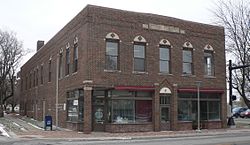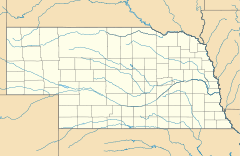- Jewell Building
-
Jewell Building
Location: Omaha, NE Coordinates: 41°16′45.93″N 95°56′47.13″W / 41.279425°N 95.946425°WCoordinates: 41°16′45.93″N 95°56′47.13″W / 41.279425°N 95.946425°W Built: 1923 Architect: Henninger,F.A.; Lof,John & Sons,Builder Architectural style: Colonial Revival Governing body: Private NRHP Reference#: 83001091[1] Added to NRHP: July 21, 1983 The Jewell Building is a city landmark in North Omaha, Nebraska. Built in 1923, it is listed on the National Register of Historic Places. Located at 2221 North 24th Street, the building was home to the Dreamland Ballroom for more than 40 years, and featured performances by many jazz and blues legends, including Duke Ellington, Count Basie, Louis Armstrong and Lionel Hampton.[2]
The building has been designated a Landmark by the City of Omaha, and is listed on the National Register of Historic Places. It is an example of the kind of venue that was integral to the cultural transmission and interchange of musical styles and art, especially in the years before television. In addition such entertainment centers were the chief ways musicians, both local and national, earned enough to make livings.
Contents
About
Located at 2221-2225 North 24th Street in the Near North Side neighborhood of Omaha, the Jewell Building was built in 1923 by James Jewell, Sr., an influential man in the local African-American community. Architect Frederick A. Henninger designed the building in the vernacular Georgian Revival style. It originally featured commercial spaces on the first floor, as well as the Dreamland Ballroom on the second floor.[3]
In 1945 Dreamland Ballroom was used as a USO center for African-American soldiers. It continued to be used for music performances until 1965.[4]
The Omaha Economic Development Council restored the building in the early 1980s. It was designated a landmark by the City of Omaha on September 9, 1980, and was listed on the National Register of Historic Places in 1983. For several years, the Jewell Building housed OEDC's corporate headquarters and served as an office center for professional people and small businesses. Two private apartments were kept in the building.[5]
The Jewell Building was converted to the Love's Center for Jazz and Art, which opened in 2008 in honor of local musician Preston Love. In the 1940s he was recruited as a young musician by the nationally famous Count Basie Band and played with them for years. The building will be used to help preserve jazz history, as well as promote new jazz and art activities. Dreamland Plaza is located adjacent to the Jewell Building at 24th and Lizzie Robinson Streets. It is the site of a recent $2 million investment by the city, including the addition of public art, a sculpture of three jazz musicians.[6]
Dreamland Ballroom
Located on the second floor of the Jewell Building, the Dreamland Ballroom was the premier nightclub for big bands and jazz in Omaha. James Jewell, Jr. booked the original Nat King Cole Trio for $25 a person for one show. Dreamland closed in the 1960s. Other performers included Dinah Washington, Earl Hines, Duke Ellington, Count Basie, Louis Armstrong and Lionel Hampton.[7] A variety of Omaha music legends including Preston Love, Anna Mae Winburn and Lloyd Hunter also played at the Dreamland.
An influential man in the black community, James Jewell invited activist Whitney Young to speak in the 1950s at Dreamland Hall about the Civil Rights Movement in the United States. Young started in Omaha and became the national director of the Urban League.
See also
- Culture in North Omaha, Nebraska
- List of jazz clubs
- Music in Omaha
External links
- Dreamland Historical Project website to protect the Dreamland Ballroom in the Jewell Building.
- Modern photo of the Jewell Building
References
- ^ "National Register Information System". National Register of Historic Places. National Park Service. 2007-01-23. http://nrhp.focus.nps.gov/natreg/docs/All_Data.html.
- ^ (nd) Nebraska National Register Sites in Douglas County. Official Nebraska Government Website. Retrieved 4/30/07.
- ^ (nd) Jewell Building/Dreamland Ballroom City of Omaha. Retrieved 4/30/07.
- ^ Landmarks, Inc. (2003) Building for the Ages: Omaha's Architectural Landmarks. Quebecor Books. p 160.
- ^ Blair, R., Deichert, J., and Bloom, H. (2005) [2005 Revised Omaha Economic Development Plan]. Omaha Economic Development Council.
- ^ "Jazz and All That", Omaha By Design. Retrieved 7/13/08.
- ^ (nd) Official Nebraska Government Website.
National Register of Historic Places Astro Theater • Cabanne Archeological Site • South Omaha Main Street Historic District • Swoboda Bakery • Trans-Mississippi Exposition siteNational Register of Historic Places and Omaha Landmark Blackstone Hotel • Jewell Building • Omaha Public Library (building) • Webster Telephone Exchange BuildingOmaha Landmark National Historic Landmark National Register of Historic Places in Omaha List National Historic Landmarks Girls and Boys Town · USS HazardHistoric districts Bemis Park Landmark Heritage District · Country Club Historic District · Drake Court Apartments and the Dartmore Apartments Historic District · Field Club Historic District · Fort Omaha · Gold Coast Historic District · Howard Street Apartment District · Old Market · Omaha Quartermaster Depot Historic District · Omaha Rail and Commerce Historic District · South Omaha Main Street Historic District · Vinton Street Commercial Historic District · Warehouses in Omaha MPSOther properties Anheuser-Busch Beer Depot · Aquila Court Building · Astro Theater · Bank of Florence · Beebe and Runyan Furniture Showroom and Warehouse · Bemis Omaha Bag Company Building · Blackstone Hotel · Bradford-Pettis House · Brandeis-Millard House · Broomfield Rowhouse · Burlington Headquarters Building · Burlington Station · Center School · Columbian School · Douglas County Courthouse · Douglas Eggerss-O'Flyng Building · Dr. Samuel D. Mercer House · Charles D. McLaughlin House · Edgar Zabriskie House · Farnam Building · First National Bank Building · First Unitarian Church of Omaha · Flatiron Hotel · Ford Hospital · Fort Omaha Guardhouse · Franklin School · Gallagher Building · Garneau-Kilpatrick House · Georgia Row House · Gen. George Crook House · G.C. Moses Block · George A. Joslyn Mansion · Gottlieb Storz House · George H. Kelly House · Guy C. Barton House · Havens-Page House · Hill Hotel · Holy Family Church · Hospe Anton Music Warehouse · Immaculate Conception Church and School · Jewell Building · Joel N. Cornish House · J.L. Brandeis and Sons Store Building · Keeline Building · Kirschbraun and Sons Creamery, Inc. · Kennedy Building · Leone, Florentine and Carpathia Apartment Buildings · Lincoln Highway · Livestock Exchange Building · Lizzie Robinson House · Malcolm X Housesite · Mary Rogers Kimball House · Mason School · Military Road Segment · Monmouth Park School · Nash Block · Normandie Apartments · North Presbyterian Church · Notre Dame Academy and Convent · Old People's Home · Omaha Bolt, Nut and Screw Building · Omaha Ford Motor Company Assembly Plant · Omaha High School · Omaha Public Library · Omaha National Bank Building · Omaha Star building · Orpheum Theater · Packer's National Bank Building · Park School · Poppleton Block · Porter-Thomsen House · Prague Hotel · Redick Tower · Rose Realty-Securities Building · Rosewater School · Sacred Heart Catholic Church Complex · Saddle Creek Underpass · Sanford Hotel · Saunders School · Simon Brothers Company · South Omaha Bridge · Christian Specht Building · Site of St. Mary's Academy · St. Cecilia Cathedral · St. Joseph Parish Complex · St. Regis Apartments · St. John's A.M.E. Church · St. Martin of Tours Episcopal Church · St. Matthias' Episcopal Church · St. Philomena's Cathedral and Rectory · Standard Oil Company Building of Nebraska · Steiner Rowhouse No. 1 · Steiner Rowhouse No. 2 · Strehlow Terrace · Swoboda Bakery · The Berkeley Apartments · The Melrose · The Sherman · Trinity Cathedral · Union Station · USS Marlin · Vinton School · Weber Mill · Webster Telephone Exchange Building · West Lawn MausoleumFormerly listed Categories:- Jazz clubs in the United States
- Landmarks in North Omaha, Nebraska
- Omaha Landmarks
- History of Omaha, Nebraska
- National Register of Historic Places in Omaha, Nebraska
- African American history in Omaha, Nebraska
- Music venues in Omaha, Nebraska
- Dance venues in the United States
- Former music venues
Wikimedia Foundation. 2010.


